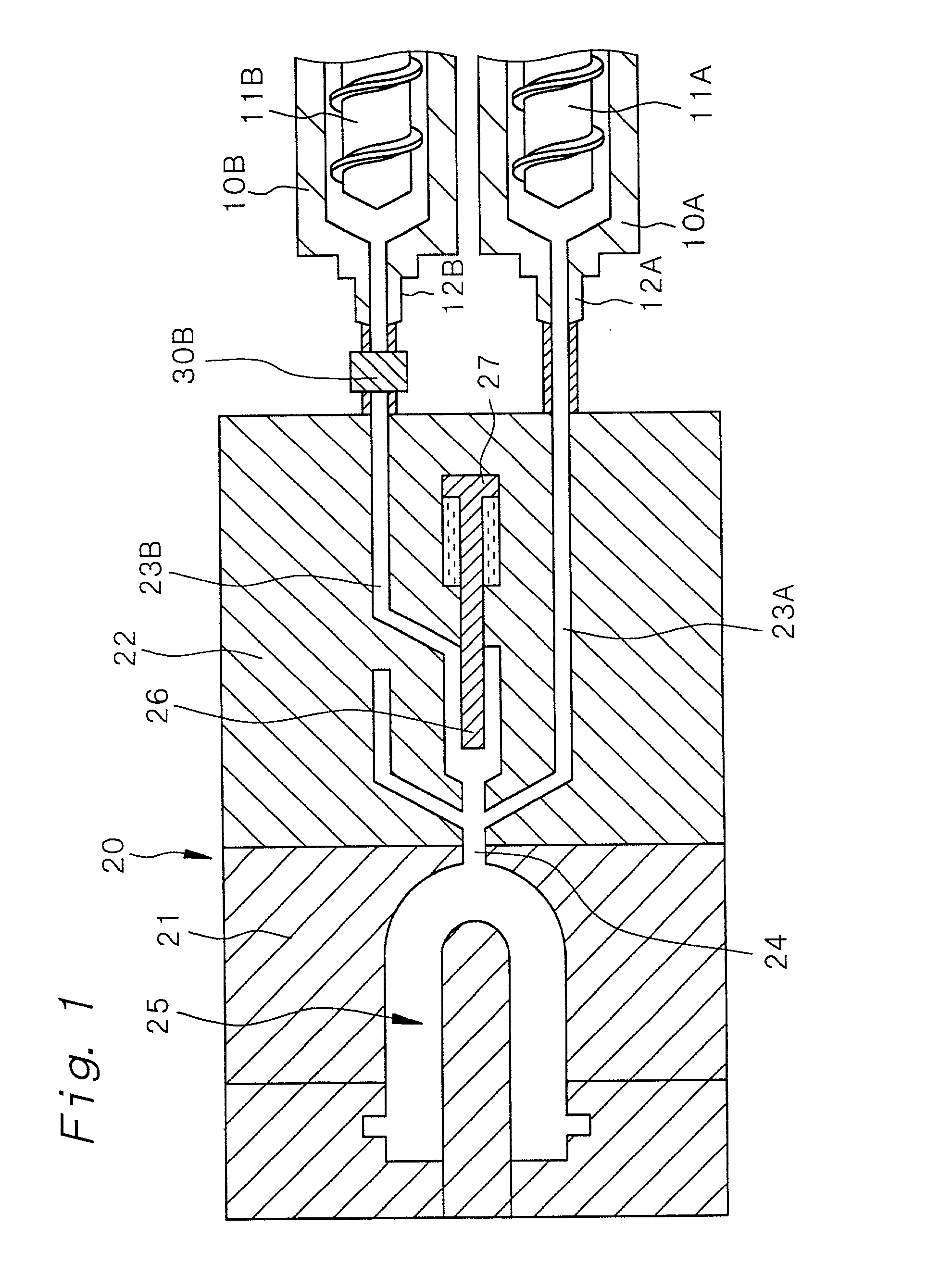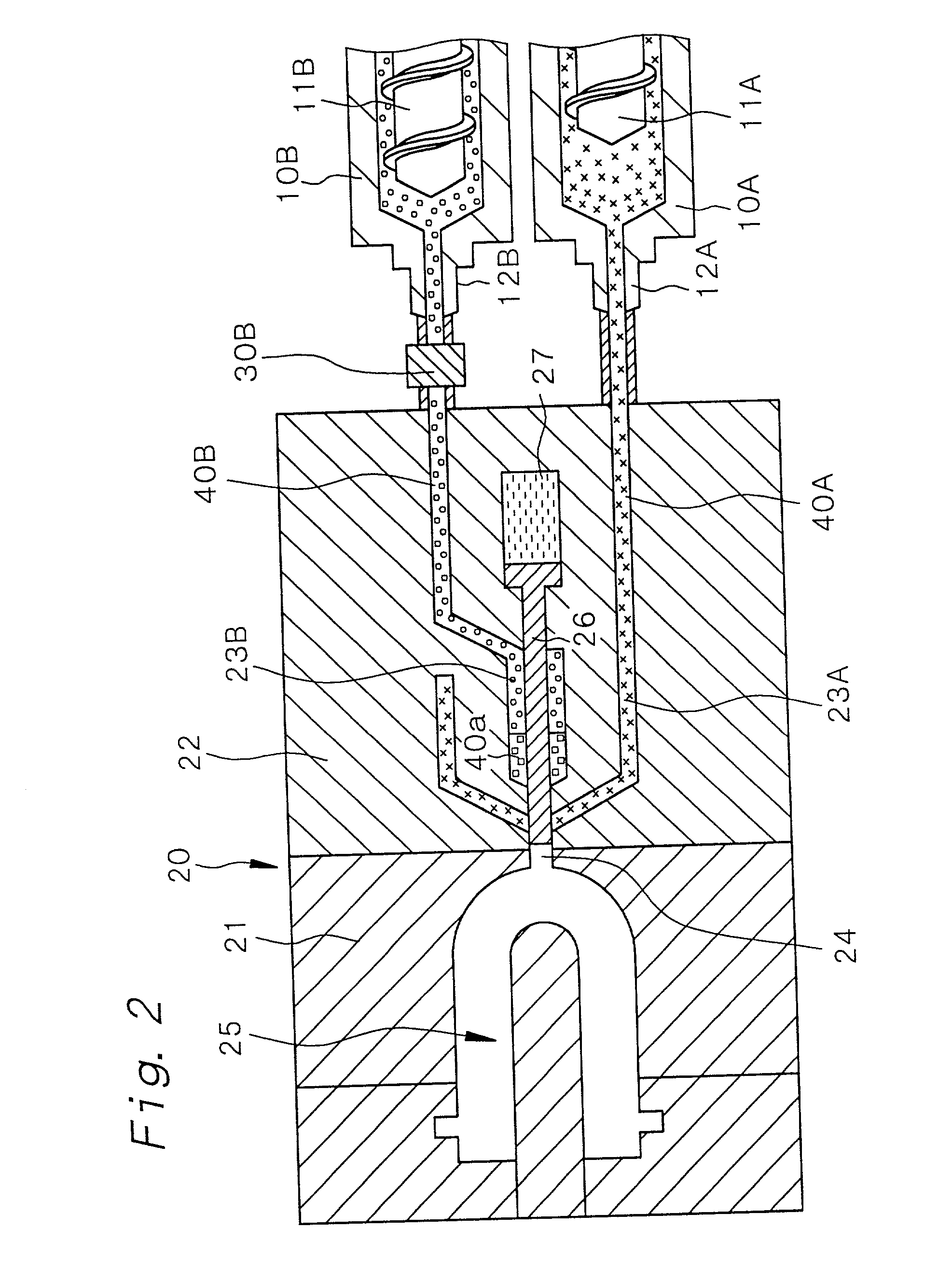Injection molding apparatus for molding multi-layered article and method of injection-molding multi-layered article
a multi-layered article and injection molding technology, which is applied in the direction of dough shaping, application, manufacturing tools, etc., can solve the problems of destabilizing the amount of the first molten resin to be injected into the cavity, not necessarily having complete performance of the container formed of a biaxially oriented thermoplastic polyester resin composed mainly of pet resin, and affecting the taste of the content. , to achieve the effect of preventing the leakage of molten resin and poor durability
- Summary
- Abstract
- Description
- Claims
- Application Information
AI Technical Summary
Benefits of technology
Problems solved by technology
Method used
Image
Examples
example 2
[0138] A polyethylene terephthalate resin having an intrinsic viscosity of 0.75 (PET resin, RT543C, supplied by Nippon Unipet K.K.) was used as a first resin 40A, and a poly-m-xylyleneadipamide resin having a relative viscosity of 2.7 (N-MXD6 resin, #6007, supplied by Mitsubishi Gas Chemical Co., Inc.) was used as a second resin 40B. PET resin, N-MXD6 resin and PET resin were alternately injected according to the steps explained in Example 1, to mold a five-layer-structured parison according to an alternate-injection molding method (the method of injection molding a multi-layered article according to the first aspect of the present invention). The parison had a length of 110 mm, a wall thickness of 4.5 mm and an outer diameter of 26.5 mm. A multi-layered bottle obtained from the above parison by a biaxial stretch blow molding method has dimensions of 200 mm in total length, 75 mm in outer diameter and 600 ml in volume.
[0139] Part of each of the first resin-flow-passage 23A and the s...
example 3
[0146] Parisons were molded using the same injection molding apparatus as that described in Example 2, except that the back flow means was replaced with a ball-type back flow control valve 30B having a ball 34 which had the same diameter as that of the ball 34 in the back flow control valve 30B used in Example 2 but was provided with a larger movement distance of the ball 34 than the back flow control valve used in Example 2.
[0147] Before injection molding, first molten resin 40a which flowed into the second resin-flow-passage 23B in a previous molding cycle was left in the second resin-flow-passage 23B in an amount equal to 15% of the volume of each cavity 25.
[0148] First, in the same manner as in [Step-100], first molten resin 40A (molten PET resin) was injected into each cavity 25 in an amount equal to 40% of the volume of each cavity 25. In this step, no first molten resin 40A flowed into the second resin-flow-passage 23B.
[0149] Then, in the same manner as in [step-110], second ...
example 4
[0152] An ethylene-vinyl acetate copolymer resin saponification product (EVOH, EVAL EF-E, supplied by Kuraray Co., Ltd.) was used in place of the N-MXD6 resin used as a second resin 40B in Example 2. The following Table 2 shows temperature conditions in Example 4. Injection molding was carried out by means of the same injection molding apparatus as that in Example 2, except that the back flow means was replaced with a ball-type back flow control valve 30 having a ball 34 which had the same diameter as that of the ball 34 in the back flow control valve 30B used in Example 3 but was provided with a larger movement distance of the ball 34 than the back flow control valve used in Example 3.
2 TABLE 2 Temperature of first molten resin 40A 270.degree. C. in injection cylinder 10A: Temperature of second molten resin 40B 230.degree. C. in injection cylinder 10B: Temperatures in first and second 270.degree. C. resin-flow-passages in hot runner block: Temperature of mold coolant 15.degree. C. ...
PUM
| Property | Measurement | Unit |
|---|---|---|
| Temperature | aaaaa | aaaaa |
| Temperature | aaaaa | aaaaa |
| width | aaaaa | aaaaa |
Abstract
Description
Claims
Application Information
 Login to View More
Login to View More - R&D
- Intellectual Property
- Life Sciences
- Materials
- Tech Scout
- Unparalleled Data Quality
- Higher Quality Content
- 60% Fewer Hallucinations
Browse by: Latest US Patents, China's latest patents, Technical Efficacy Thesaurus, Application Domain, Technology Topic, Popular Technical Reports.
© 2025 PatSnap. All rights reserved.Legal|Privacy policy|Modern Slavery Act Transparency Statement|Sitemap|About US| Contact US: help@patsnap.com



